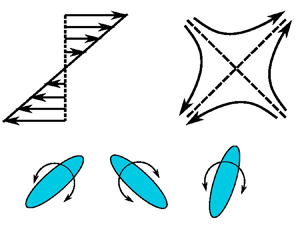Article contents
Rotational Taylor dispersion in linear flows
Published online by Cambridge University Press: 08 October 2024
Abstract

The coupling between advection and diffusion in position space can often lead to enhanced mass transport compared with diffusion without flow. An important framework used to characterize the long-time diffusive transport in position space is the generalized Taylor dispersion theory. In contrast, the dynamics and transport in orientation space remains less developed. In this work we develop a rotational Taylor dispersion theory that characterizes the long-time orientational transport of a spheroidal particle in linear flows that is constrained to rotate in the velocity-gradient plane. Similar to Taylor dispersion in position space, the orientational distribution of axisymmetric particles in linear flows at long times satisfies an effective advection–diffusion equation in orientation space. Using this framework, we then calculate the long-time average angular velocity and dispersion coefficient for both simple shear and extensional flows. Analytic expressions for the transport coefficients are derived in several asymptotic limits including nearly spherical particles, weak flow and strong flow. Our analysis shows that at long times the effective rotational dispersion is enhanced in simple shear and suppressed in extensional flow. The asymptotic solutions agree with full numerical solutions of the derived macrotransport equations and results from Brownian dynamics simulations. Our results show that the interplay between flow-induced rotations and Brownian diffusion can fundamentally change the long-time transport dynamics.
Information
- Type
- JFM Papers
- Information
- Copyright
- © The Author(s), 2024. Published by Cambridge University Press
References
- 2
- Cited by


